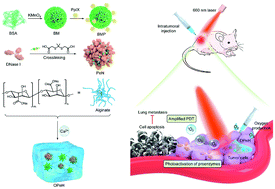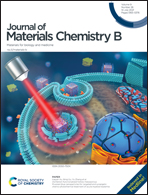Oxygen-producing proenzyme hydrogels for photodynamic-mediated metastasis-inhibiting combinational therapy†
Abstract
Photodynamic therapy (PDT) has provided a promising approach for the treatment of solid tumors, while the therapeutic efficacy is often limited due to the hypoxic tumor microenvironment, resulting in tumor metastasis. Herein, we report an oxygen-producing proenzyme hydrogel (OPeH) with photoactivatable enzymatic activity for PDT enabled metastasis-inhibiting combinational therapy of breast cancer. This OPeH based on alginate is composed of protoporphyrin IX (PpIX) conjugated manganese oxide (MnO2) nanoparticles, which act as both the photosensitizer and oxygen-producing agent, and singlet oxygen (1O2)-responsive proenzyme nanoparticles. In the hypoxic and acidic tumor microenvironment, MnO2 can generate 1O2 to promote PpIX-mediated PDT with an amplified 1O2 generation efficiency, which also triggers the cleavage of 1O2-responsive linkers and cascade activation of proenzymes for cancer cell death. This combinational therapy upon photoactivation not only greatly inhibited the tumor growth, but also suppressed lung metastasis in a mouse xenograft breast tumor model, which is impossible in the case of PDT alone. This study thus provides a proenzyme hydrogel platform with photoactivatable activity for metastasis-inhibiting cancer therapy with high efficacy and safety.

- This article is part of the themed collection: Journal of Materials Chemistry B HOT Papers


 Please wait while we load your content...
Please wait while we load your content...